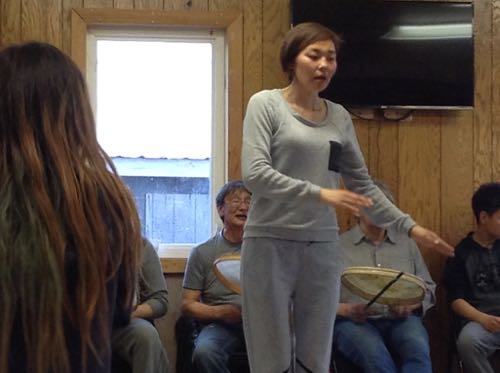Sunday Night at the Community Center
 These five drummers each led the singing and rhythm throughout the dance session. George, second from right, was the overall lead drummer.
These five drummers each led the singing and rhythm throughout the dance session. George, second from right, was the overall lead drummer.
It was just after 10pm. The sun was still bright, and locals were starting to trickle in to the community center. Some finished their texting outside the door, while others beelined for the communal coffee pot in the corner of the gathering hall. It was all very casual, yet quiet, and everyone knew their place.
Tonight, you see, there was an Eskimo dance, complete with drummers, dancers, families, and spectators. In Siberian Yupik tradition, these dances are performed in communal spaces rather than in private homes. The social aspect is important and, it seems, reflective, of their importance of community.
Before television there was storytelling and dance was just one means of telling those stories. These communal dances are a way to maintain tradition, passing it along to younger kids, and for elders watching to sing along and follow the movements from their seats. Their dances express everyday events, such as whaling, hunting and gathering, picking berries, skinning a walrus, landing a plane, seal hunting, or sighting a god upon a hill. Movements are methodic and with the drummers simultaneous drumming and singing, it's absolutely mesmerizing. Dancers need a keen eye to mimic the interactions between animal and subsistence survivors.
 Men can be dancers, too, and this song was about whaling. The man in this photo is a fisherman, and I had met him at the dock earlier in the morning. His dancing was very emphatic.
Men can be dancers, too, and this song was about whaling. The man in this photo is a fisherman, and I had met him at the dock earlier in the morning. His dancing was very emphatic.
The group of drummers do have a lead drummer, but any of them can begin a song. The drums are handmade from birch or driftwood steamed into a roundish shape, while the drum is formed from the lining of a walrus stomach, and you'll see the drummers periodically spray them with water in between songs (they used to just spit on them).
Once the drummers begin, dancers step onto the floor to express their clan's traditional moves. One of the dancers explained that she doesn't dance to any of the songs unless it's one from her specific clan. When she was just a child, she was taught specifically to only dance those dances associated with the traditions of her clan, or tribe. There are also welcome and farewell dances, though, and those can be joined by anyone, regardless of clan.
 The young and old dance together in Siberian Yupik community dances.
The young and old dance together in Siberian Yupik community dances.
 Dancers sing along sometimes with the drummers.
Dancers sing along sometimes with the drummers.
The drummers play a song twice, the first as a sort of "warm-up", then the second time is more forceful, perhaps with translations, words, and more dancers joining in. Drummers are also singers, and sometimes the dancers sang, too. Composers are the songwriters, and it seems as though different clans each have highly touted composers. When composers die, Carolyn, one of the older dancers, described to me how elaborate some of the farewell dances could be, both as celebration and an expression of mourning.
 Dancers are dressed informally, although some do own more traditional clothing for special ceremonies.
Dancers are dressed informally, although some do own more traditional clothing for special ceremonies.
Locals were intent on informing me that they are Siberian Yupik, and therefore more closely related to dancers and rituals in Russia than anywhere else in Alaska, even though other Eskimo groups have Eskimo dances, too. Intriguingly, there is a mix of traditional dance expression from "ancient times" with an openness for personal touches from the younger generation. What was striking, though, was the intergenerational gathering; one dancer's 89-year old Savoonga-born grandmother attended, sang, and expressed her movements while seated.
One of the dancers was excited to show me her dress that a Russian dancer had handsewn for her, and proceeded to put it on over her t-shirt and jeans, along with a pair of white gloves. "Russian dresses are different from Savoonga dresses because they have pockets, and ours don't, that's how you know," according to Carolyn. Typically, dancers in Savoonga wear jeans, sweatshirts, and everyday clothing, and there is no formal dance "membership" as in other areas or groups. The informality of the dance was a powerful indicator that it's done as a normal part of everyday life. Most Sunday evenings you can find the community gathered for these dances, so even though it helps maintain tradition, it's also still very relevant as "something you do" as a Yupik community member.
I wished I could have stayed longer.
Today's Tweet
Drumming, singing, dancing, composing. Another example of bridging old and new, with elders remembering alongside young children. #DanceAsStorytelling #EskimoDance #SiberianYupik


Add new comment